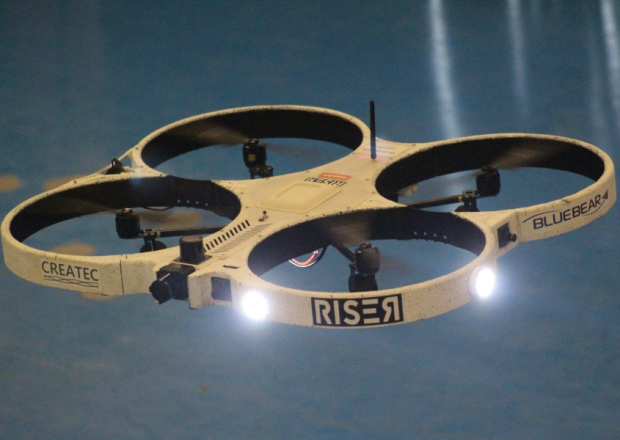http://www.forbes.com/sites/ryanmac/2015/06/12/why-gopro-decided-to-build-a-drone/
By Ryan Mac and Frank Bi
GoPro CEO Nicholas Woodman, a 39-year-old billionaire with a flair for the dramatic, usually has a way of pumping up crowds. Last month though, as he was set to make one of the most significant announcements in his company’s 13-year history, he fell a little flat.
“Do you guys all want GoPro to make a quadcopter?” Woodman asked onlookers at the Code Conference in Ranchos Palos Verdes, Calif. He was met with tepid cheers and two claps.
“Oh come on, do you guys all want GoPro to make a quadcopter?” he repeated, raising his voice and eliciting a slightly louder response. “Okay, GoPro is making a quadcopter. It’s official.”
Perhaps one of the worst kept secrets in Silicon Valley, Woodman’s announcement in front of investors and technology executives finally confirmed a new direction for GoPro, which, in the year since its initial public offering, has attempted to portray itself as more than just a camera company. While there’s been talks of GoPro’s forays into media and content, a quadcopter–or more generally, an unmanned aerial vehicle (UAV)–emphasizes that the company can embrace new ideas and products.
“They invented the action camera category and there’s not many more features that they can offer [on the cameras],” said Michael Pachter, an analyst with Wedbush Securities. “GoPro wants to show that it’s innovating.”
With consumer drones, however, GoPro may be innovating as well as playing catch up. The company is behind drone manufacturers like 3D Robotics and Shenzhen, China-based DJI, which sold its first mass market drone in 2013 and is on course to do $1 billion in sales this year. By far the market leader, DJI raised $75 million last month at an $8 billion valuation, larger than GoPro’s current $7.5 billion market capitalization.
While GoPro’s shares are trading at nearly double its IPO price of $24, its stock is down from the dizzying heights of last fall when holiday sales expectations buoyed investor confidence. With its drone, GoPro is hoping to reignite interest in its stock, a move which has worked to some extent with shares jumping 6.5% on the day of Woodman’s announcement.
GoPro’s CEO declined to comment for this article through a spokesperson, but those close to the company said that Woodman has been considering the development of his own drone since mid-2013. For most in the industry, it’s a logical move.
“Consumer and commercial drones are regularly used at sporting events like skiing, snowboarding and surfing–the same places where GoPro rules,” said Bilal Zuberi a partner at Lux Capital. “So it makes sense that GoPro does not want to leave that field open for DJI and others, and hurt its standing as the dominant brand among sports enthusiasts.”
3D Robotics CEO Chris Anderson, whose company has made GoPro its official camera for its new consumer drone, Solo, noted that there is a “natural synergy” between drone enthusiasts and GoPro users.
“What GoPro allows is for people to shoot their lives in cinematic styles, and that’s exactly what drones can offer,” he said.
GoPro’s eventual move into the drone market may put it at odds with current partners like 3D Robotics, who is the first outside company ever to use GoPro’s branding on the packaging on their products. Up until now, drone manufacturers and GoPro have been largely symbiotic, with Anderson roughly estimating that as many as 10% of GoPros purchased today are being attached to UAVs.
Though GoPro could go from a collaborator to a competitor, the 3D Robotics chief said it’s not a move that was entirely unexpected as GoPro had poached his former product management director Pablo Lema last June to head up its drone program. Anderson also said that the drone industry “is not a zero-sum game” and that the entry of quality manufacturers to the market will only grow awareness and interest in the space.
Former DJI North America head Colin Guinn tried to broker deals between DJI and GoPro that never materialized. (Photo: Matthew Mahon for Forbes)
Former DJI North America head Colin Guinn tried to broker deals between DJI and GoPro that never materialized. (Photo: Matthew Mahon for Forbes)
That sentiment is likely not shared by DJI, whose signature consumer UAV line, the Phantom, proved to be an early inspiration for Woodman’s desire to build a drone, said sources. By the middle of 2013, DJI and GoPro were said to be negotiating a variety of deals brokered by then DJI North America head Colin Guinn. Originally, the plan was to develop a drone together, with GoPro providing the branding and sales channels, while DJI offered engineering expertise and manufacturing capabilities.
“Initially [GoPro and DJI] wanted to make a product together for GoPro to sell, but the negotiation never came to fruition,” DJI CEO Frank Wang told FORBES in a recent interview. They treated us like the original equipment manufacturers (OEMs). The deal came out to roughly this: GoPro would make two points of profit, and I’d make one point.”
“They dealt with us like how they dealt with Taiwanese OEMs, so we never had a successful official partnership,” he added.
Sources said that conversations between the two companies would attempt to develop different relationships, with discussions of DJI using GoPro’s established retail channels to distribute its drones. Due to disagreements, however, nothing was ever signed, and DJI lost most of its connection to the American camera maker following the departure of Guinn, who ended up suing his former employer over an ownership dispute in 2014, before moving to 3D Robotics.
These days, even though GoPros are still heavily used on DJI products, CEO Wang has attempted to wean his customers off the American brand. DJI is developing its own cameras, which Wang claims are better than GoPro’s offerings.
“From the beginning to now, we never wanted to be in the shadow of someone else,” he said.
GoPro risks being overshadowed by the likes of DJI and 3D Robotics if it doesn’t move quickly with its drone. Growth in GoPro’s sales, which increased 42% to $1.39 billion in 2014, has slowed after doubling or tripling annually up until 2013. Contrast that with the fast-paced consumer drone market where DJI is expected to double sales this year after closing 2014 with about $500 million in revenue.
Yet before it sells a single drone, GoPro has plenty to do beyond making an announcement. UAVs are far more complex than any camera and require not only hardware, but also proprietary software. Both DJI and 3D Robotics began by developing software autopilots before attempting to build full consumer products.
Sources close to GoPro said there have been at least three different designs for a four-propeller drone and it’s unclear if a decision has been made as to the exact specifications for the device. GoPro declined to give a timeline of when its drone would be ready to ship to consumers. It took seven years from DJI’s founding for Wang to develop and ship the company’s first Phantom. Six years on from its founding, 3D Robotics is just releasing Solo to the market.
“Drones are hard,” said Anderson. “They’re unlike a camera where you can buy sensors on the streets of Shenzhen and put something together. It’s really, really hard to do well and you can’t just buy the parts.”
With reporting Heng Shao in Hong Kong.





